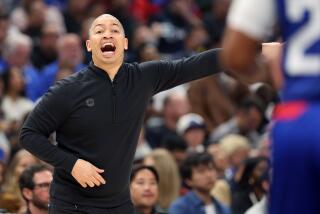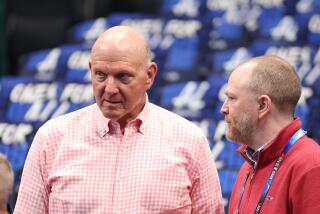Clippers Are Facing $8 Million in Losses Since Move to L.A.
The Clippers, who made a controversial move from San Diego to Los Angeles before the 1984-85 season in hopes of improving both their financial and basketball records, have done neither.
The National Basketball Assn. team had total net losses of $4.4 million last season and have projected total net losses of $4 million by the end of this season.
That information, a rare look at an NBA team’s financial picture, has been acquired by The Times through sources. It could be particularly significant because of the pending lawsuit by the NBA against the team. The NBA, suing the Clippers for $25 million because the team made the move to Los Angeles without league permission, is asking a federal court to determine if the league has the right to dissolve the franchise. It is possible that heavy financial losses by the franchise could become a part of the NBA’s case against the Clippers.
A trial date has not been set. But on March 31, in a San Diego federal court, Judge Leland C. Nielsen will preside over the Clippers’ motion for a summary judgment.
Most of the Clippers’ losses since moving to Los Angeles in May, 1984, have come from nonoperating expenses such as interest and principal reduction on loans, legal fees and leasehold improvements at the Sports Arena.
Of the $4,431,523 the Clippers lost last season, $3,553,188 came from nonoperating expenses, and the net operating loss was $878,335. For the 1985-86 season, the Clippers have projected a total net loss of $4.012 million. The net operating loss, after subtracting revenues and expenses, is expected to be $837,000. The nonoperating expenses are estimated at $3.175 million.
Additionally, the Clippers estimate that, from Feb. 1 to July 1, expenses will exceed revenue by an average of $400,000 a month. That would result in nearly a $2-million loss in that five-month period.
Sources said that approximately 15 of the 23 National Basketball Assn. teams either broke even or made money last season. The NBA reportedly receives a financial statement from each team, but it is believed to include only operating revenues and expenses.
Donald T. Sterling, Clipper owner, could not be reached Saturday. Alan Rothenberg, club president, declined to comment about the Clippers’ financial dealings.
In Sterling’s four previous seasons as the Clipper owner, the first three in San Diego, the club has had net operating losses. In 1981-82, Sterling’s first season as owner, the Clippers had operating losses of $770,442. The club lost $353,042 in 1982-83 (its best financial season) and $584,881 in 1983-84, the club’s last season in San Diego.
Other information acquired by The Times deals with a wide range of topics, from paid attendance figures rather than announced figures to players and coaches salaries, season-ticket sale declines and expenditures on things such as legal fees, rent at the Sports Arena and money spent on feeding the media before home games.
Some of the findings:
--Through their first 23 games, the Clippers announced attendance averaged 8,166 a game, but the actual paid attendance averaged 6,409.
That is a difference of 1,757. The Clippers also list 1,034 complimentary season tickets. So, if everyone given a complimentary ticket for the season attended each game, then the Clippers would be inflating their publicly announced attendance by 723 a game.
The NBA’s policy on attendance disclosure is for each team to announce the number of tickets distributed, not the actual turnstile count.
For example, the Clippers announced a crowd of 7,656 for their home opener Oct. 26 against the Houston Rockets. The paid attendance was 5,472. On Jan. 24, when the Clippers posted their first win over the Lakers since moving to Los Angeles, the announced crowd was 14,858, the actual paid attendance 11,127.
--The Clippers are paying their three coaches $211,000 in total salary, believed to be the lowest in the NBA.
Head Coach Don Chaney makes $90,000, the lowest among his peers, leaving $121,000 for assistants Don Casey and Brad Greenberg. The average salary for an assistant coach is said to be approximately $80,000, but some assistants earn more than $100,000.
--The Clippers’ player payroll stands at $4,580,188.42.
Salaries for the Clippers’ starters: Rookie center Benoit Benjamin, $575,000; forward Cedric Maxwell, $505,000; forward Kurt Nimphius, $187,500 (prorated from his salary of $225,000 after being acquired from Dallas in late November); guard Norm Nixon, $150,000 plus a $600,000 loan, and guard Marques Johnson, $1.1 million.
Guard Derek Smith, who has missed all but 11 games with a knee injury and illness, earns $375,000, $250,000 coming from a bonus. Smith becomes a free agent after this season.
Perhaps the most underpaid Clipper is forward Rory White, a part-time starter who makes $83,125.
Interestingly, the Clippers have already projected the money they want to spend in 1986-87 on salaries for players who will become free agents at the season’s end. The Clippers, for example, are hoping to sign Smith for $500,000 and give White a raise to $100,000.
--Season-ticket sales are down from 5,044 in 1984-85 to 3,605 this season, a 28% decrease. However, the Clippers season-ticket prices have risen 27%.
--The Clippers’ rent at the Los Angeles Sports Arena has been $84,000 for each of the last two seasons, considerably less than what they paid at the San Diego Sports Arena. But the Clippers paid $350,389 in arena building costs last season and estimate they will pay $275,000 this season, considerably more than in San Diego.
--In 1981-82, Sterling’s first season as the Clipper owner, $3,902 was allocated for pregame meals at home games for the media covering the team. Last season, that figure was $28,890, and this season’s projection is for $21,000.
--The Clippers, who have several lawsuits pending, spent $510,638 on legal expenses last season. They have budgeted $600,000 for this season.
More to Read
Get our high school sports newsletter
Prep Rally is devoted to the SoCal high school sports experience, bringing you scores, stories and a behind-the-scenes look at what makes prep sports so popular.
You may occasionally receive promotional content from the Los Angeles Times.






